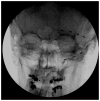Peripheral nerve stimulation for trigeminal neuropathic pain
- PMID: 22270735
- PMCID: PMC4664452
Peripheral nerve stimulation for trigeminal neuropathic pain
Abstract
Facial pain is a complex disease with a number of possible etiologies. Trigeminal neuropathic pain (TNP) is defined as pain caused by a lesion or disease of the trigeminal branch of the peripheral nervous system resulting in chronic facial pain over the distribution of the injured nerve. First line treatment of TNP includes management with anticonvulsant medication (carbamazepine, phenytoin, gabapentin, etc.), baclofen, and analgesics. TNP, however, can be a condition difficult to adequately treat with medical management alone. Patients with TNP can suffer from significant morbidity as a result of inadequate treatment or the side effects of pharmacologic therapy. TNP refractory to medical management can be considered for treatment with a growing number of invasive procedures. Peripheral nerve stimulation (PNS) is a minimally invasive option that has been shown to effectively treat medically intractable TNP. We present a case series of common causes of TNP successfully treated with PNS with up to a 2 year follow-up. Only one patient required implantation of new electrode leads secondary to electrode migration. The patients in this case series continue to have significant symptomatic relief, demonstrating PNS as an effective treatment option for intractable TNP. Though there are no randomized trials, peripheral neuromodulation has been shown to be an effective means of treating TNP refractory to medical management in a growing number of case series. PNS is a safe procedure that can be performed even on patients that are not optimal surgical candidates and should be considered for patients suffering from TNP that have failed medical management.
Figures



Similar articles
-
Peripheral stimulation for treatment of trigeminal postherpetic neuralgia and trigeminal posttraumatic neuropathic pain: a pilot study.Neurosurgery. 2004 Jul;55(1):135-41; discussion 141-2. Neurosurgery. 2004. PMID: 15214982 Clinical Trial.
-
Burst or Conventional Peripheral Nerve Field Stimulation for Treatment of Neuropathic Facial Pain.Neuromodulation. 2019 Jul;22(5):645-652. doi: 10.1111/ner.12922. Epub 2019 Jan 10. Neuromodulation. 2019. PMID: 30629320
-
A minimally invasive surgical technique for the treatment of posttraumatic trigeminal neuropathic pain with peripheral nerve stimulation.Pain Physician. 2012 Sep-Oct;15(5):E725-32. Pain Physician. 2012. PMID: 22996867
-
Peripheral Nerve Stimulation for Facial Pain Using Conventional Devices: Indications and Results.Prog Neurol Surg. 2020;35:60-67. doi: 10.1159/000509574. Epub 2020 Jul 17. Prog Neurol Surg. 2020. PMID: 32683375 Review.
-
Motor cortical stimulation for the treatment of trigeminal neuropathic pain secondary to an arteriovenous malformation. A case report.Rev Fac Cien Med Univ Nac Cordoba. 2023 Sep 29;80(3):275-288. doi: 10.31053/1853.0605.v80.n3.41142. Rev Fac Cien Med Univ Nac Cordoba. 2023. PMID: 37773339 Free PMC article.
Cited by
-
Effective Management of Trigeminal Neuralgia by Neurostimulation.Ochsner J. 2015 Summer;15(2):193-5. Ochsner J. 2015. PMID: 26130986 Free PMC article.
-
Electrical stimulation of cranial nerves in cognition and disease.Brain Stimul. 2020 May-Jun;13(3):717-750. doi: 10.1016/j.brs.2020.02.019. Epub 2020 Feb 23. Brain Stimul. 2020. PMID: 32289703 Free PMC article. Review.
-
Neuromodulation for cephalgias.Surg Neurol Int. 2013 Apr 17;4(Suppl 3):S136-50. doi: 10.4103/2152-7806.110662. Print 2013. Surg Neurol Int. 2013. PMID: 23682340 Free PMC article.
-
Trigeminal Neuralgia.Asian J Neurosurg. 2017 Oct-Dec;12(4):585-597. doi: 10.4103/ajns.AJNS_67_14. Asian J Neurosurg. 2017. PMID: 29114270 Free PMC article. Review.
-
Peripherally Induced Reconditioning of the Central Nervous System: A Proposed Mechanistic Theory for Sustained Relief of Chronic Pain with Percutaneous Peripheral Nerve Stimulation.J Pain Res. 2021 Mar 12;14:721-736. doi: 10.2147/JPR.S297091. eCollection 2021. J Pain Res. 2021. PMID: 33737830 Free PMC article. Review.
References
-
- Dworkin RH. An overview of neuropathic pain: Syndromes, symptoms, signs, and several mechanisms. Clin J Pain. 2002;18:343–349. - PubMed
-
- Johnson MD, Burchiel KJ. Peripheral stimulation for treatment of trigeminal postherpetic neuralgia and trigeminal posttraumatic neuropathic pain: A pilot study. Neurosurgery. 2004;55:135–141. discussion 141–142. - PubMed
-
- Boogaard S, Heymans MW, Patijn J, de Vet HCW, Faber CG, Peters ML, Loer SA, Zuurmond WWA, Perez R. Predictors for persistent neuropathic pain - A Delphi Study. Pain Physician. 2011;14:559–568. - PubMed
-
- Mao J. Opioid-induced abnormal pain sensitivity: Implications in clinical opioid therapy. Pain. 2002;100:213–217. - PubMed
-
- Vallejo R, Barkin RL, Wang VC. Pharmacology of opioids in the treatment of chronic pain syndromes. Pain Physician. 2011;14:E343–E360. - PubMed
Publication types
MeSH terms
Grants and funding
LinkOut - more resources
Full Text Sources
Medical
